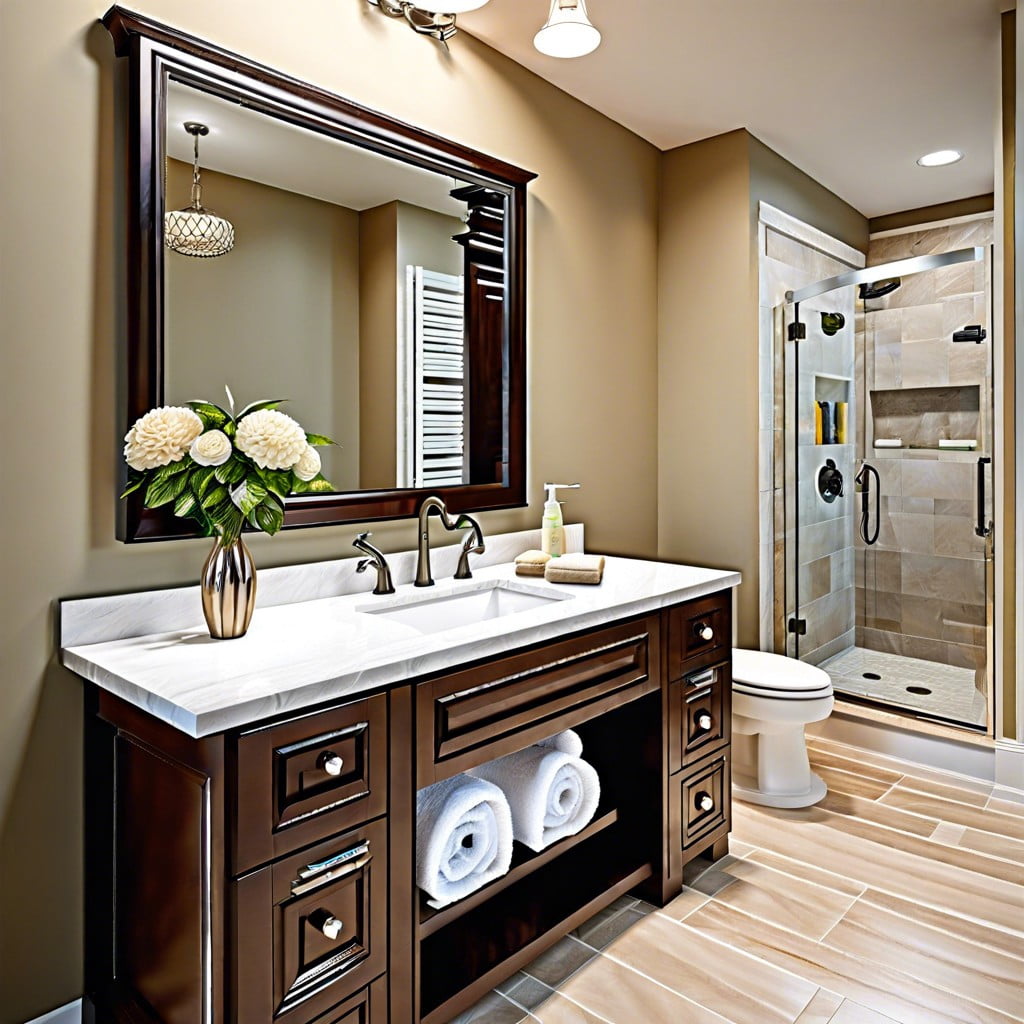Last updated on
Learn the practical steps to install a bathroom vanity and elevate your bathroom’s style with functional sophistication.
Key takeaways:
- Ensure safety precautions: Shut off water and power, wear protective gear.
- Remove old vanity and sink: Turn off water, disconnect supply lines, remove sink and vanity cabinets.
- Secure new vanity to the wall: Find wall studs, level the vanity, drill pilot holes, secure with screws.
- Install sink and faucet: Apply caulk, attach sink and faucet, connect supply lines, check for leaks.
- Consider DIY vs. hiring a professional: DIY requires skills and tools, hiring a pro ensures expertise.
Safety Considerations

Before embarking on your vanity installation project, prioritizing personal safety is imperative. Electricity and plumbing are serious business; thus, ensure that water supply lines and power to the bathroom are entirely shut off to prevent any accidental electrocution or water damage. It is not enough to guess; verify that the power and water are disconnected.
Protective gear is non-negotiable. Dust masks and safety goggles are your allies against airborne particles and debris, especially if cutting or drilling is involved. Hands are often overlooked, yet they are your primary tools. So, wear gloves to safeguard against splinters and sharp edges.
It is also worth noting that bathroom spaces can be confined and inadvertently lead to risky maneuvers. Be aware of your surroundings when handling heavy vanities and sharp tools. This means being mindful of awkward positions that could cause strain or injury. Remember, vanity installation is not a race; take your time to avoid mistakes that could harm you or your bathroom.
Further, familiarize yourself with the tools needed for the job, and do not improvise with tools you are unsure how to use. Misusing tools not only leads to a shoddy installation but can also spell injury for the inexperienced. If you hit a wall—figuratively speaking—consider consulting a professional to avoid literal damage to yourself and your property.
Remove Existing Vanity and Sink
Before diving into the task of removing your current vanity and sink, make sure you’ve turned off the water supply to avoid any plumbing disasters. Locate the shutoff valves for both the hot and cold water supply lines under the sink and twist them closed. Turn on the faucet to drain any remaining water in the pipes, then disconnect the supply lines using an adjustable wrench.
Next, tackle the sink by detaching the P-trap—the curved pipe under the sink—which is often the culprit for trapping debris and causing clogs. Have a bucket handy to catch any water left inside. After that, you’ll want to remove the sink from the countertop. Most sinks are sealed with caulk or plumber’s putty, and a putty knife can be used to break this seal. If the sink is clipped to the countertop, be sure to remove those clips first.
The vanity cabinets are typically attached to the wall with screws and may also be caulked along the back edge. Inspect the inside of the cabinet to locate these screws. Once found, unscrew them carefully, ensuring you have proper support for the vanity if it’s large or heavy to prevent it from crashing down once it’s unfastened.
In many cases, vanities are also attached to their countertops. If yours is, it must be separated. This could involve removing screws or cutting through adhesive, depending on how it’s attached. Some force may be required, but use caution to avoid damaging the wall or surrounding fixtures.
After the screws are out and the caulk has been sliced through, you should be able to gently pull the vanity away from the wall. Remember, a smooth and patient approach will minimize damage to your bathroom walls and flooring. Keep in mind every step you take during removal you will be reversing when installing the new vanity, so careful removal is just as important as precise installation.
Secure the Vanity to the Wall
Correctly anchoring your vanity to the wall is a critical step that prevents tipping or movement, ensuring a safe and stable installation. If you skip this part, you’re flirting with potential disaster, especially in bathrooms frequented by children or the elderly where safety is paramount.
Firstly, locate the wall studs, as these will be the secure points for mounting the vanity. Use a stud finder for accuracy—the last thing you want is to play a guessing game with your bathroom fixtures. Once the studs are found, mark their locations.
Now, position the vanity against the wall and align it with your markings. It’s essential to ensure it’s level—shims can be used to adjust the height and provide a stable base if your floor is uneven. Uneven installation could lead to improper drainage or a vanity that seems to “dance” every time you nudge it.
With the vanity perfectly placed and leveled, drill pilot holes through the vanity’s mounting holes into the studs. It’s like setting up a date between your vanity and the studs; they need to fit together snugly. Use screws long enough to secure the vanity to the studs but not so long that they become an unwelcome guest through the wall.
Remember, proper anchoring is not about showing off your strength. Over-tightening the screws can damage the vanity or wall. Think of it as a firm handshake—not a crushing grip. Secure the vanity evenly and it won’t play hide and seek every time you need it to stay put.
Install the Sink and Faucet
After securing the vanity to your bathroom wall, attaching the sink and faucet is the next critical step. Doing this accurately prevents leaks, which can cause significant damage over time.
Begin with the sink. If it’s a drop-in style, apply a bead of silicone caulk around the edge of the opening in the vanity and gently lower the sink into place. Press down to ensure a secure seal. For undermount sinks, you’ll need to attach the sink to the underside of the countertop before setting the countertop onto the vanity.
Next, move on to the faucet. Thread the water supply lines through the designated holes in the sink or countertop and fasten them to the faucet underneath. Don’t forget to apply plumber’s tape to the threads to ensure a water-tight connection.
Once both supply lines are connected, attach the drain assembly. This usually involves inserting the drain through the sink opening and tightening the nut from below. Add a little plumber’s putty under the flange for a watertight seal.
Finally, connect the water supply lines to the corresponding shut-off valves on the wall. These should be clearly marked for hot and cold water. Make sure these connections are snug, but be careful not to overtighten as this can damage the fittings.
Turn on the water to check for leaks. A dry run now can save a flood later. If any drops are spotted, tighten the connections a little more and recheck. Remember, patience pays off when it comes to plumbing.
DIY Vs. Hire a Pro
Embarking on a DIY bathroom vanity installation can be a satisfying project for those with a bit of home improvement savvy, but it’s not for everyone. The reality is, going the DIY route requires a solid understanding of plumbing and carpentry, not to mention a healthy collection of tools. It’s important to weigh the potential savings against the time investment and the need for precision.
On the flip side, hiring a professional ensures that the job is done right the first time. Yes, it costs more upfront, but you’re paying for expertise and efficiency. A pro will have the right tools and experience to tackle unforeseen issues, which are almost a given in any home renovation project.
Consider this: a wonky installation can lead to costly damages from water leaks or structural problems down the line. If you’re not confident in your ability to execute the installation flawlessly, bringing in a professional might be the smarter financial decision in the long run.
Recap





